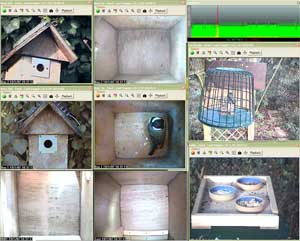 This
picture shows the second screen with its eight feed windows. If you click
on the image you will get a bigger version!
This
picture shows the second screen with its eight feed windows. If you click
on the image you will get a bigger version!We now have three nest boxes. The first two and the colour cameras installed inside them were purchased from BoxWatch. One still has the original camera, but after 6 years the other camera developed an intermittent fault and had to be replaced. The third nest box was installed in January 2007 and replaced a sparrow terrace that we had installed on the side of the house several years ago. We replaced it because the only bird that had shown any interest in the terrace was a bluetit which took over the middle section in spring 2006 in order to raise a brood of chicks!
The third box was designed and built by me in order to house two cameras, one in the conventional place over the nest and the other to the side of it. This high quality camera is also IR sensitive and so we have installed IR lighting as well as the normal lighting. Details of the construction of this box can be found elsewhere on this site.
The cables from these four and four other cameras are connected to my PC directly using two four port video capture cards, one being a Euresys Picolo Pro 2 and the other from the same stable called the Junior 4. The PC is a self built dual processor machine based on two Intel Xeon 3.00GHz processors, 1GB main memory, 160GB Samsung SATA disk drive, and an Asus A9250 display card running under Windows XP Pro. This display card supports two monitors, one of which is mainly used to display the 8 feed windows.
 This
picture shows the second screen with its eight feed windows. If you click
on the image you will get a bigger version!
This
picture shows the second screen with its eight feed windows. If you click
on the image you will get a bigger version!
Each of the original two nest boxes has an external camera pointed at the nest box hole so that we can see the comings and goings of the parent birds. The final two cameras point to our bird table and a fat block feeder elsewhere in the garden.
The green stripe you can see in the top right of the screen shows the traffic from my PC to the internet. When this picture was taken a viewer was watching on the webcam and the green displays the traffic this causes.
The software used to capture the images from these cameras is i-Catcher Console from i-Catcher. As well as the software, we bought the video capture cards and most of the video cameras from i-Catcher. Three of the cameras are the Sony IR LED Day/Night cameras. These produce images of excellent quality and are weatherproof, a distinct advantage for this type of use!
In 2004, the lighting in each box was enhanced by adding three white LEDs and a resistor in parallel with the existing light. The LEDs are Nichia NSPW510BS obtainable from Maplin as product NR73Q. The LEDs have a max reverse voltage of 4v and were installed in series with the resistor which is a 1k variable resistor set to about 600 ohms. The additional slightly bluish light has noticeably improved the colour of the bluetit's plumage.
All the key software is from i-Catcher. As well as its webcam and motion detecting software, i-Catcher provides HTTP server and videocam software that has greatly simplified building our website. All their software is available for free trial from their site.
Our current ISP is Zen Internet and we are using their standard 8Mb/s broadband service. As we are about 3½ to 4km from the Woking exchange, this link only operates at about 3 Mb/s download and 300 kb/s upload speeds but this is still very much faster that the standard 0.5 Mb/s broadband service we had been using. We have a DrayTek Vigor2800 ADSL2/2+ Security Router that enables all our PCs to share this link.
Additional digital photographs are sometimes taken using a conventional digital camera.
The biggonline website is hosted by 1&1. As well as hosting this Bluetit website, we also use it to host the Bigg Birding Forum which can be found at http://forum.biggonline.co.uk/
Many people have asked us how to go about setting up a webcam. Although we are not experts, we have written some notes which we hope will answer some of these questions.
If you want to know more, please contact us either by using the Feedback form, or via the forum.